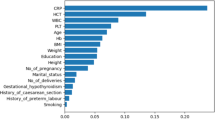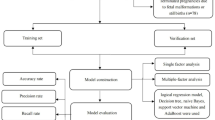Abstract
One of the most challenging tasks currently facing the healthcare community is the identification of premature labour. Premature birth occurs when the baby is born before completion of the 37-week gestation period. The incomplete understanding of the physiology of the uterus and parturition means that premature labour prediction is a difficult task. The reason for this may be that the initial symptoms of preterm labour occur commonly in normal pregnancies. There is some misclassification in regard to recognizing full-term and preterm labour; approximately 20% of women who are identified as reaching full-term labour actually deliver prematurely. This paper explores the applicability of Artificial Immune System (AIS) technique as a new methodology to classify term and preterm records. Our AIS approach shows better results when compared with Neural Network, Decision Tree, and Support Vector Machines, achieving more than 92% accuracy overall.
Access this chapter
Tax calculation will be finalised at checkout
Purchases are for personal use only
Preview
Unable to display preview. Download preview PDF.
Similar content being viewed by others
References
Garfield, R.E., Maner, W.L.: Physiology and electrical activity of uterine contractions. Semin. Cell Dev. Biol. 18(3), 289–295 (2007)
William, R.E.G., Maner, L.: Identification of human term and preterm labor using artificial neural networks on uterine electromyography data. Ann. Biomed. Eng. 35(3), 465–473 (2007)
WebMd, Premature Labor (2012), http://www.webmd.com/baby/premature-labor
Keijzer-Veen, M.G., van der Heijden, A.J.: The Effect of Preterm Birth on Kidney Development and Kidney Function over Time. In: Morrison, J.C. (ed.) Preterm Birth - Mother and Child (2012)
Greenough, A.: Long Term Respiratory Outcomes of very Premature Birth (<32 weeks). Semin. Fetal Neonatal Med. 17(2), 73–76 (2012)
Fergus, P., Cheung, P., Hussain, A., Al-Jumeily, D., Dobbins, C., Iram, S.: Prediction of Preterm Deliveries from EHG Signals Using Machine Learning. PLoS One 8(10), e77154 (2013)
Garfield, R.E., Maner, W.L., MacKay, L.B., Schlembach, D., Saade, G.R.: Comparing uterine electromyography activity of antepartum patients versus term labor patients. Am. J. Obstet. Gynecol. 193(1), 23–29 (2005)
Rabotti, C.: Characterization of uterine activity by electrohysterography. Technische Universteit Eindhoven (2010)
WelcomeBabyHome, The Birth Process (2006), http://www.welcomebabyhome.com/pregnancy/pregnancy_birth_process.htm (2013)
Lucovnik, M., Maner, W.L., Chambliss, L.R., Blumrick, R., Balducci, J., Novak-Antolic, Z., Garfield, R.E.: Noninvasive uterine electromyography for prediction of preterm delivery. Am. J. Obstet. Gynecol. 204(3), 228, e1–10 (2011)
Rabotti, C., Mischi, M., Oei, S.G., Bergmans, J.W.M.: Noninvasive estimation of the electrohysterographic action-potential conduction velocity. IEEE Trans. Biomed. Eng. 57(9), 2178–2187 (2010)
Forrest, S., Perelson, A., Allen, L., Cherukuri, R.: Self-Nonself Discrimination in a Computer. In: Proc. of IEEE Symposium on Research in Security and Privacy, Oakland, USA, pp. 202–212 (1994)
Jerne, N.: Towards a network theory of the immune system. Annals of Immunology 125, 373–389 (1974)
de Castro, L.N., Von Zuben, F.J.: The clonal selection algorithm with engineering applications. In: Proceedings of GECCO 2000, Workshop on Artificial Immune Systems and Their Applications, pp. 36–37 (2000)
Greensmith, J., Twycross, J., Aickelin, U.: Dendritic cells for anomaly detection. In: Proc. of the Congress on Evolutionary Computation (CEC), pp. 664–671 (2006)
Brownlee, J.: Artificial immune recognition system (AIRS): A review and analysis. CISCP, ICT. Swinburne University of Technology, Tech. Rep. TR-1-02 (2005)
Author information
Authors and Affiliations
Editor information
Editors and Affiliations
Rights and permissions
Copyright information
© 2014 Springer International Publishing Switzerland
About this paper
Cite this paper
Huang, R., Tawfik, H., Hussain, A.J., Al-Askar, H. (2014). The Application of Artificial Immune Systems for the Prediction of Premature Delivery. In: Huang, DS., Jo, KH., Wang, L. (eds) Intelligent Computing Methodologies. ICIC 2014. Lecture Notes in Computer Science(), vol 8589. Springer, Cham. https://doi.org/10.1007/978-3-319-09339-0_83
Download citation
DOI: https://doi.org/10.1007/978-3-319-09339-0_83
Publisher Name: Springer, Cham
Print ISBN: 978-3-319-09338-3
Online ISBN: 978-3-319-09339-0
eBook Packages: Computer ScienceComputer Science (R0)




